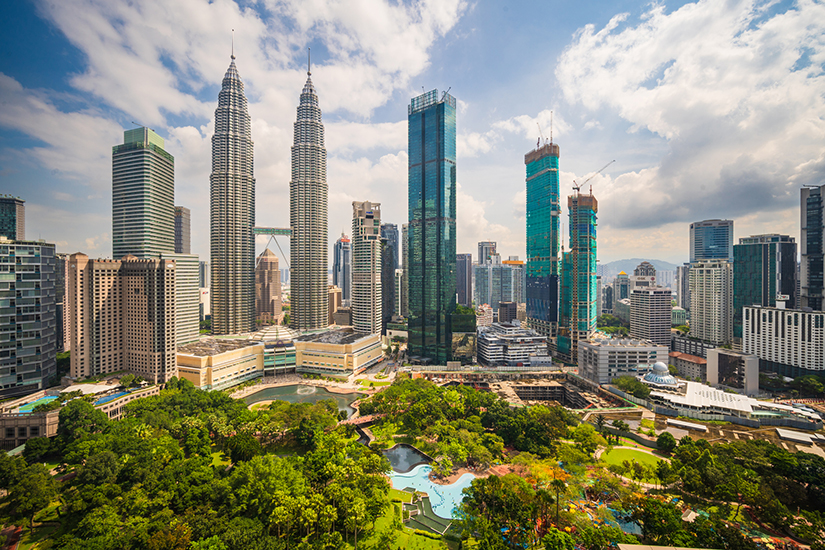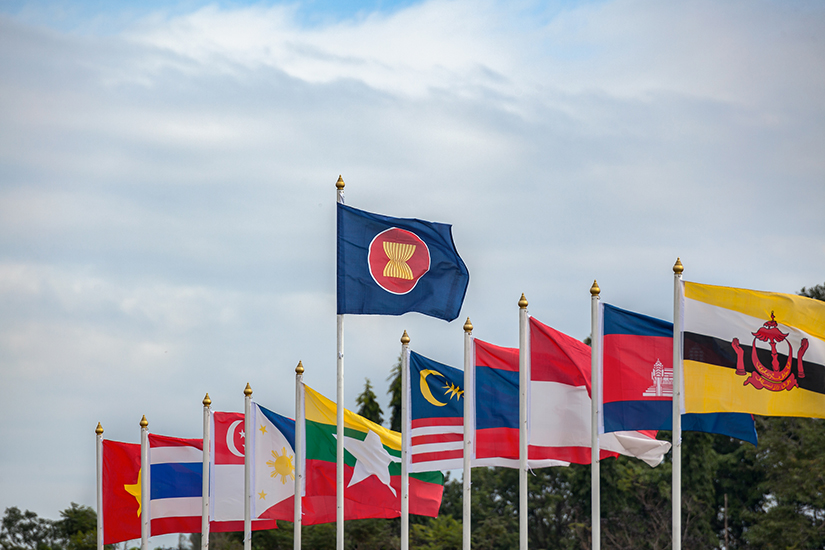The chair of the Association of Southeast Asian Nations (ASEAN) rotates annually based on the alphabetical order of the English names of member states, and in 2025 the role is being held by Malaysia. The chair is responsible for hosting and presiding over various meetings—culminating in the summit—and taking the lead in setting the agenda for each meeting. ASEAN has been enhancing its global presence owing to the region’s robust economic growth and as a prominent voice in the Global South, but it also faces a number of internal and external challenges.
How will Malaysia address these challenges during its chairmanship? In the following, I will examine the issues confronting ASEAN in 2025, with a focus on the paths likely to be charted by the chair.

Focus on the Economy
Prime Minister Anwar Ibrahim outlined his aspirations for Malaysia’s ASEAN chairmanship at the October 2024 ASEAN Summit in Vientiane, Laos. Among the strategies he said he would prioritize were expanding trade and investment linkages, fostering digital transformation in the region, reinforcing member states’ economic fundamentals, and reinventing, restructuring, and recalibrating their economies while leveraging each other’s strengths.[1] The focus was clearly on the economy.
Malaysia subsequently announced that the theme for ASEAN in 2025 would be “inclusivity and sustainability.” The launching ceremony to announce the logo and theme, held at the Malaysian Ministry of Foreign Affairs, was a grand affair. Foreign Minister Mohamad Hasan underscored the importance of 2025 as marking the tenth anniversary of the formal establishment of the ASEAN Community in 2015, adding that Malaysia would lead the effort to adopt the ASEAN Community Vision 2045 to chart the region’s strategic direction in the years to come.[2]
Two Challenges: Myanmar and the South China Sea
Of the two components of Malaysia’s chairmanship theme, sustainability relates directly to the economic agenda. Inclusivity, meanwhile, is linked to two key regional challenges: Myanmar and the South China Sea.
Myanmar has been in a state of civil war since the February 2021 coup, with no resolution in sight four years later. Territorial disputes in the South China Sea remain unresolved, with tensions running high—sometimes spilling over into maritime clashes—between the Philippines and China. ASEAN’s response to these disputes has lagged, as other member states also have competing claims. Both internal divisions and external pressures thus threaten ASEAN’s inclusivity.
Malaysia’s first initiative as chair was the January 2025 hosting of the ASEAN Foreign Ministers’ Retreat in Langkawi. The chair’s press statement reaffirmed the need to enhance the region’s competitiveness and resilience in a time of digital transformation and in the face of an increasingly complex and unpredictable global environment. It also looked forward to concluding a comprehensive, high-quality, and forward-looking ASEAN Digital Economy Framework Agreement (DEFA) in 2025.[3]
The DEFA seeks to offer a comprehensive roadmap to empower businesses and stakeholders across ASEAN by accelerating trade growth, enhancing interoperability, creating a safe online environment, and increasing the participation of small and medium enterprises. Key topics like digital trade, cross-border e-commerce, cybersecurity, digital IDs, and digital payments are considered, along with emerging topics like artificial intelligence.[4] ASEAN aims to solidify regional economic development through digital transformation and thereby promote political and social stability in the region and in individual member states.

ASEAN’s engagement with Myanmar, on the other hand, remains at a standstill. The press statement of the Foreign Ministers’ Retreat simply reiterated deep concern over the escalation of civil conflict and humanitarian situation. It noted the minimal progress on the implementation of ASEAN’s Five-Point Consensus (5PC) over the past four years, and it upheld the decision limiting the participation of Myanmar’s military regime at ASEAN summits and foreign ministers’ meetings.[5]
As chair, Malaysia appointed former Secretary General for Foreign Affairs Othman Hashim as ASEAN special envoy on Myanmar in hopes of breaking the deadlock by facilitating dialogue between the military junta and antimilitary forces. Foreign Minister Mohamad has emphasized that ASEAN’s priority is a ceasefire, not the elections the military regime is pushing for.[6] However, prospects for resolving the crisis remain highly uncertain.
There has similarly been little progress on the South China Sea, as efforts to establish a Code of Conduct (COC), which ASEAN has been pursuing for over 30 years, remain stalled.[7] ASEAN touted the completion of the third reading of the single draft COC negotiating text (SDNT) as representing positive momentum,[8] but there is no timeline for concluding an effective and substantive COC with China.
The security situation remains unpredictable, as tensions between the Philippines and China continue to escalate and concerns mount over Taiwan, but ASEAN has yet to develop effective countermeasures. In fact, China’s economic and political influence over ASEAN countries has steadily grown, making it increasingly difficult to negotiate with Beijing from a position of strength.
There is no magic bullet to resolve ASEAN’s two regional challenges—Myanmar and the South China Sea—regardless of who is chair. This likely explains Malaysia’s emphasis on economic development, particularly digital transformation. In fact, prior to the ASEAN Informal Foreign Ministers’ Retreat, Malaysian Secretary General for Foreign Affairs Amran Mohamed Zin tempered expectations regarding Myanmar and the South China Sea, stating, “To say that we will have a solution immediately is going to be very ambitious.”[9]
Navigating Relations with Trump
ASEAN views US President Donald Trump’s second term with considerable anxiety. ASEAN does not seem to be on Trump’s radar at the moment, but if tariffs and other forms of economic pressure are implemented, they would have far-reaching repercussions on the economies of the region and member states.[10]
Relations between chair Malaysia and the United States have eroded over the conflict in Gaza. Many in Malaysia resent the strong US support for Israel, and the Anwar administration, in response to domestic sentiment, has maintained ties with Hamas. Malaysia has also applied for membership in BRICS, and in the face of US-China rivalry, there is a growing tendency to see China as a preferred partner over the United States.[11]
Malaysia reacted strongly to Trump’s controversial proposal to take control of Gaza and resettle Palestinians, and as the ASEAN chair, it is pushing for a collective ASEAN statement opposing this plan.[12] Malaysia is expected to invite Trump to the East Asia Summit and also engage with Washington in other multilateral forums, but the president is unlikely to show much interest. For Malaysia and ASEAN as a whole, no significant developments are expected in multilateral and bilateral relations with the United States.
Malaysia is likely to approach its ASEAN chairmanship with great enthusiasm. But while the region’s economic prospects are bright, its political and security challenges remain serious. Coming under scrutiny will be not only Malaysia’s skills as chair but also ASEAN’s overall resilience in addressing these challenges.

(2025/03/13)
Notes
- 1 “Malaysia’s strategies as Asean chair in 2025 focus on regional value chains, says Anwar,” The Star, October 9, 2024.
- 2 Ministry of Foreign Affairs of Malaysia, “Launching Ceremony of the Logo and Theme of ASEAN-Malaysia Chairmanship 2025,” October 22, 2024. The ASEAN Community is a comprehensive initiative consisting of the political-security, economic, and socio-cultural pillars.
- 3 ASEAN, “Press Statement by the Chair of the ASEAN Foreign Ministers’ Retreat,” January 19, 2025, p.
- 4 ASEAN, “Digital Economy Framework Agreement (DEFA): ASEAN to leap forward its digital economy and unlock US$2 Tn by 2030,” August 19, 2023.
- 5 ASEAN, “Press Statement by the Chair,” p. 7 (see note 3). Regarding the Five-Point Consensus, see my article (in Japanese) on this site, “Myanma kiki to ASEAN: Chukai gaiko no tenbo” (The Myanmar Crisis and ASEAN: Prospects for Mediation Diplomacy), IINA, July 21, 2021.
- 6 Daniel Azhar, “Asean tells Myanmar junta peace, not election, is priority,” Reuters, January 19, 2025.
- 7 For a history of the COC, see Tomotaka Shoji, “Minami Shina-kai no ryoyuken mondai: Chugoku no saishinshutsu to Betonamu o chushin to suru Tonan-Ajia no taio” (The South China Sea Territorial Disputes: China’s Re-entry and Southeast Asia’s Response, Centering on Vietnam), NIDS Security Studies, vol. 14, no. 1, December 2011, p. 3.
- 8 ASEAN, “Press Statement by the Chair,” p. 2 (see note 3).
- 9 “Malaysia takes on Asean mantle but tempers expectations on Myanmar, South China Sea,” Straits Times, January 19, 2025.
- 10 Tomotaka Shoji, “US-ASEAN Relations under Trump 2.0: Concerns Outweigh Expectations,” IINA, January 8, 2025.
- 11 Ibid.
- 12 Junaid Ibrahim Martin Carvalho and Gerard Gimino, “Asean to issue statement against Trump’s proposal to remove Palestinians from Gaza, says Tok Mat,” The Star, February 6, 2025.

